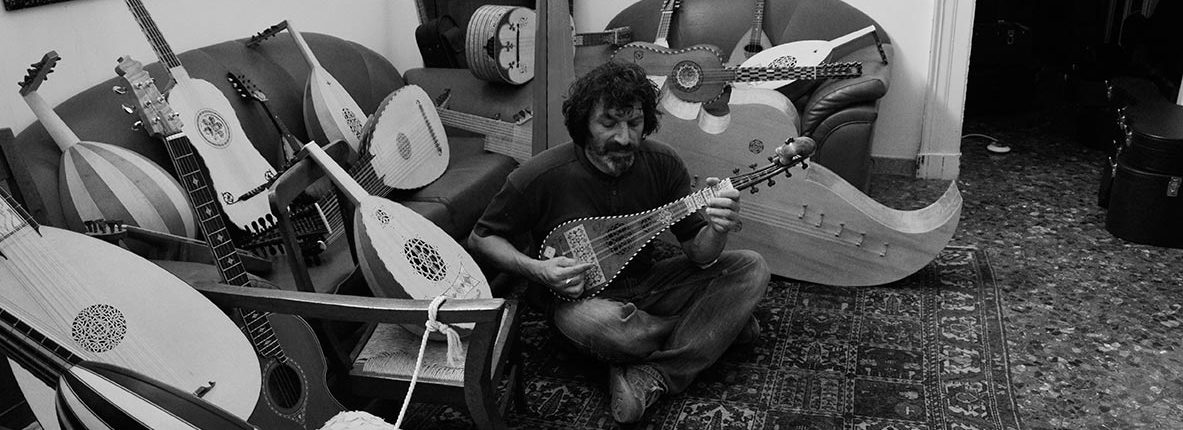ANTONIO DATTIS is a cabinet-maker, restorer and luthier. His training course began, when he was a child, learning the basics of woodworking first as a carpenter’s shopkeeper, then as an apprentice to a master cabinetmaker and furniture restorer, starting to build his first musical instruments in empirical way, sometimes without ever having seen a true one. Later he learned the constructive technique of stringed musical instruments and completed his training at the workshop of the luthier Alfredo Baroni.
His formidable cabinetmaking skills allowed him to reconstruct particularly elaborate ancient instruments, both faithful copies of historical instruments, and some of his creation.
Its production is mainly dedicated to medieval, Renaissance and baroque instruments with plucked strings (lutes, arciliuti, tambours, guitars and mandolins, also using materials such as mammoth ivory), but also includes string instruments (violins, violas, double basses and bass violes).
Particularly unusual and difficult to construct instruments are his true passion: in 2007 he made one of the three copies of octobasses in the world for the Musical Instrument Museum of Phoenix, Arizona, where he is currently exposed and regularly played (In June 2011 the “Remote Control Production” studios used the instrument for recording a soundtrack, for the movie “The Hunger Games”).
In 2010 he exhibited some of his lutes in the exhibition “Liuti del Mediterraneo by Dinko Fabris & Davide Rebuffa”, at the “Fiera del Levante” in Bari.
In 2013 he won the 1st prize of the European Award for “Lifelong Passions 2013”, awarded to those who in the European Union have shown a particular dedication and commitment in the development of a passion.
In 2014, based on the only document received, published in the “Musick’s Monument” by Thomas Mace (1674), he built the first copy ever made from the seventeenth century to today of the “Dyphone” or “two-necked lute with 50 strings”, which is officially presented in London at the “Lute Society”.
He gave lectures on the research and implementation of the Dyphone at the “Scola Cantorum” in Basel and at the “Civica Scuola di Liuteria” in Milan.
Also in 2014 he built the first copy of the 1574 “Cetera di Girolamo Virchi” kept in Vienna at the Kunsthistorisches Museum.
In 2016 he built, for the Castle of “Carlo Gesualdo Di Venosa”, the first copy of the 1924 ”Chitarra Magno Longo” conserved at the Museum of Musical Instruments of the “Castello Sforzesco” in Milan; the first copy of the “Prototype of Arciliuto” invented by Alessandro Piccinini, preserved in Vienna at the Kunsthistorisches Museum.
His copy of the Magno Longo guitar has been exhibited next to the original one in the Sforzesco Castle Museum.
Clicca qui per la versione in italianoANTONIO DATTIS è ebanista, restauratore e liutaio. Il suo percorso formativo è iniziato, poco più che bambino, apprendendo le nozioni basilari della lavorazione del legno dapprima come garzone di bottega di un falegname, poi come apprendista di un maestro ebanista e restauratore di mobili, cominciando a costruire i suoi primi strumenti musicali in maniera empirica, a volte senza mai averne visto uno vero. In seguito ha appreso la tecnica costruttiva degli strumenti musicali a corda e completato la sua formazione presso la bottega del liutaio tarantino Alfredo Baroni.
La sua formidabile manualità di ebanista gli ha consentito di ricostruire strumenti antichi particolarmente elaborati, sia copie fedeli di strumenti storici, sia alcuni di sua creazione. La sua produzione è dedicata prevalentemente agli strumenti medievali, rinascimentali e barocchi a corde pizzicate (liuti, arciliuti, tiorbe, chitarre e mandolini, anche utilizzando materiali come l’avorio di mammut), ma comprende anche strumenti ad arco (violini, viole, contrabbassi, viole da gamba).
Gli strumenti particolarmente insoliti e di difficile costruzione sono la sua vera passione: nel 2007 ha realizzato una delle tre copie di ottobassi esistenti al mondo per il Musical Instrument Museum di Phoenix, Arizona, dove è attualmente esposto e regolarmente suonato (Nel giugno 2011 la casa di produzione cinematografica ”Remote Control Production” ha utilizzato lo strumento per la registrazione di una colonna sonora, per il film “The hunger Games”).
Nel 2010 ha esposto alcuni suoi liuti all’interno della mostra Liuti del Mediterraneo a cura di Dinko Fabris & Davide Rebuffa, presso la Fiera del Levante di Bari.
Nel 2013 ha vinto il 1° premio dell’ European Award for Lifelong Passions 2013, conferito a coloro che nell’Unione Europea hanno mostrato ua particolare dedizione e impegno nello sviluppo di una passione.
Nel 2014, basandosi sull’unico documento pervenutoci, pubblicato nel Musick’s Monument di Thomas Mace (1674), ha costruito la prima copia mai realizzata dal XVII secolo ad oggi del “Dyphone” o “liuto a due manici con 50 corde”, che è stato presentato ufficialmente a Londra presso la “Lute Society” Ha tenuto conferenze sulla ricerca e la realizzazzione del Dyphone presso la “Scola Cantorum” di Basilea e presso la “Civica Scuola di Liuteria” di Milano.
Sempre nel 2014 ha costruito la prima copia della “Cetera di Girolamo Virchi del 1574” conservata a Vienna presso il Kunsthistorisches Museum.
Nel 2016 ha costruito, per il Castello di Carlo Gesualdo Di Venosa, la prima copia della ”Chitarra Magno Longo” del 1624 conservata presso il Museo degli strumenti Musicali del Castello Sforzesco di Milano; la prima copia del “Prototipo di Arciliuto” inventato da Alessandro Piccinini, conservato a Vienna presso il Kunsthistorisches Museum. La sua copia della Chitarra Magno Longo, è stata esposta affianco all’originale nel Museo del Castello Sforzesco.

